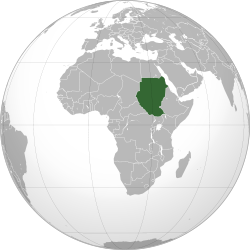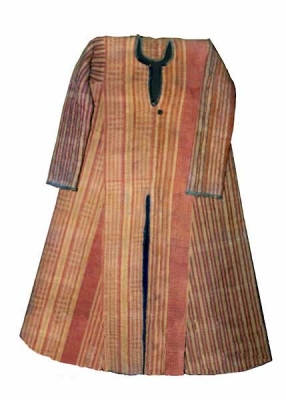Jibbah (1919.29.7)
 SudanJibbah from Sudan, Africa. Collected by Harry Hamilton Jackson. Given to the Museum in 1919.
SudanJibbah from Sudan, Africa. Collected by Harry Hamilton Jackson. Given to the Museum in 1919.
This long, quilted coat is known as a jibbah. It was worn by an Ansar, a Sufi Muslim warrior and follower of El Mahdi, in northern Sudan in the late 19th century. The split down the front enabled it to be worn both on horseback and on foot. Muslim Europeans would have worn it under mail but in the Sudan and Nigeria it was often worn alone. It is made from cotton called dammur, spun by women and woven by men. This jibbah has a more complex and colourful woven pattern than most, the conventionally vertical and horizontal quilting lines spaced 1-3 cm apart.
There is a bullet hole in the chest and, since it is well established that the majority of Madhist (previously termed 'Dervish') armours in British collections were retrieved from the battlefield, it is very likely that this jibbah was taken from a dead soldier after the British rout at Omdurman in 1898.
A Place in History
The jibbah partakes of a long Islamic tradition of making heavy, quilted cotton armours, known as al-qutun (literally, 'cottons'). These thick padded tunics were either worn on their own or under armour. In the case of the latter, they served as additional layer of protection and prevented heat and friction irritating the warrior's skin. During the medieval period, jibbah were found all over Islamic Africa and Europe.
Sudanese farmers traditionally grew short staple cotton. The working of cotton was a strictly gendered process. The spinning of the fibres into a doubly thick thread was an exclusively female task. This thread was then woven into dammur by men and used to produce all heavy duty and stiff cotton textiles in the Sudan - such as the jibbah.
Like many Islamic countries, the Sudan contains a number of active tariqa - Sufi religious orders or brotherhoods in search of mystical enlightenment, nucleated around a teacher or chain of teachers. These teachers ultimately can claim some decent from the Prophet himself or one of the early Caliphs. The participants in the Mahdist movement are now conventionally spoken of as Ansar rather than Dervishes, which is a rather non-specific Persian term for an Islamic ascetic. The Mahdist movement was named after Mohammed Ahmad, known as El Mahdi (d.1885). He was originally a member of the Sammaniyya tariqa but following conflict with the order's leader, he left and established his own movement, which rapidly grew to be the largest politico-religious movement of the Sudan. It was both a secular revolutionary movement, inspired by hatred of Ottomans rule since the 1820s, and an attempt to purify Sudanese Islam into a more orthodox form by instituting sharia law. El Mahdi declared jihad (holy struggle) against the Ottomans and seized power in 1881. In 1882, the British desire to control the Suez Canal brought Egypt and Sudan under British rule. In 1885, El Mahdi died and was succeeded by one of his deputies, the Khalifa Abdullahi, who led the movement until its defeat and destruction at the Battle of Omdurman in 1898.
Omdurman (September 2nd, 1898) was one of the most poignant and mismatched battles ever fought. A combined army of Sudanese, Egyptian and British forces, numbering 25,800 men, marched under the command of General Sir Horatio Kitchener. They faced 52,000 Mahdists, the single largest military force mobilised in Africa since the Crusades. The Mahdists had a few thousand rifles but their arms comprised mostly, spears, swords and daggers. Most wore jibbah like this one as their primary protection. Metal armour was a rarity because many of the soldiers could not afford it. Thus, even though the Anglo-Egyptian-Sudanese force was significantly smaller, their Maxim machine guns and Nile gunboats proved unbeatable. The Mahdists employed their traditional tactic of a mass charge of 16,000 men in tight formation but this only sent them straight into the muzzles of the Maxim guns. Over 4,000 men died outright in this first charge, and not one came within 50 metres of the Anglo-Sudanese line. One British officer described the scene as "not a battle, but an extermination". At the end of the Battle of Omdurman, British dead numbered 48, and wounded 434. Mahdist dead numbered 9,700, and wounded 13,000.
Omdurman served as horrific proof of the senselessness of old-fashioned, open-field tactical manoeuvres on a battlefield covered by modern, long-range machine guns and artillery; it was a grisly lesson that ultimately led to the tactics of attrition and trench warfare used in the Boer and First World Wars





